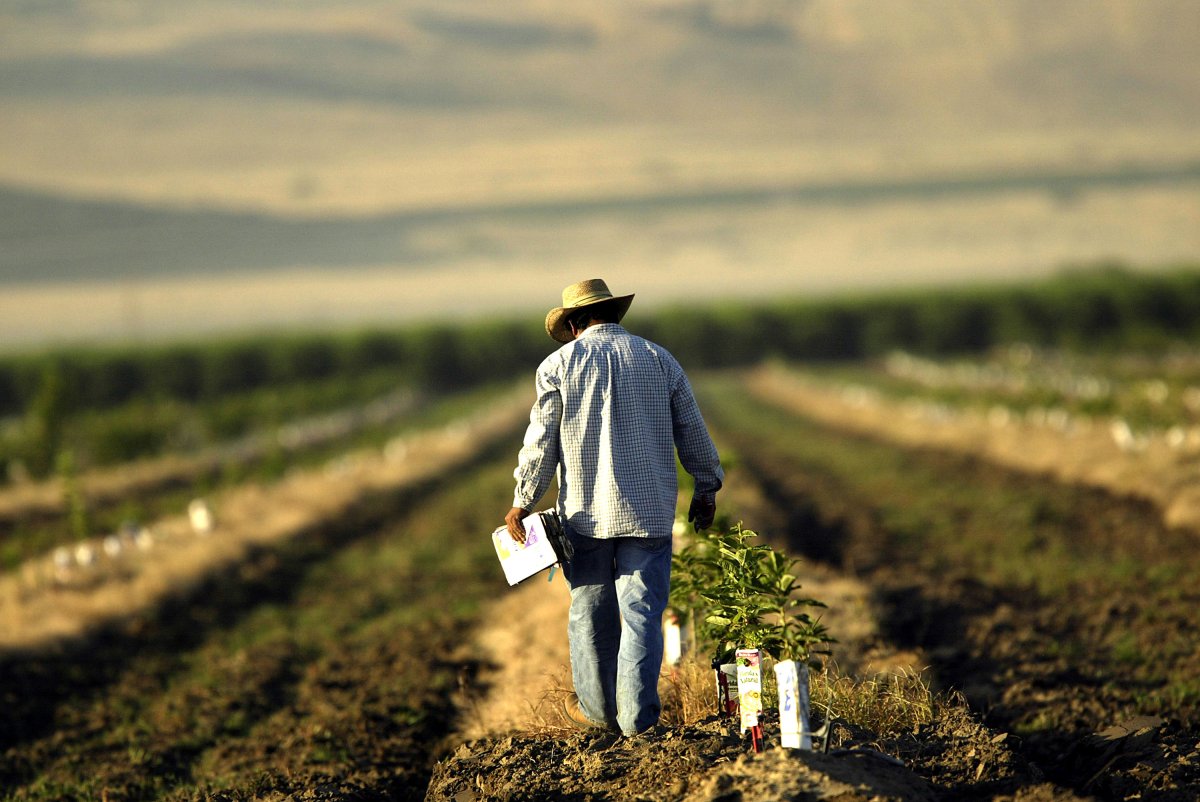Alexander Fabino
The United States lost 141,733 farms over the course of five years, in part due to a broken workforce system that has led to a worker shortage. But a report with 15 recommendations unanimously agreed upon by a bipartisan group of lawmakers aims to address that shortage, and it has immigration laws in its sights.
Amidst the decline of farms and workers across the U.S, the House Committee on Agriculture's bipartisan Agriculture Labor Working Group (ALWG), co-chaired by Eric Crawford from Arkansas and Donald Davis from North Carolina, has formulated a comprehensive proposal targeting the root of the crisis: overhauling the H-2A visa program.

A farm worker labors in a field. A bipartisan group of lawmakers have introduced a proposal that would expand the current H2-A visa program to address the labor shortage on U.S. farms.
The H-2A visa program, designed to allow non-immigrant foreign workers entry into the U.S. for temporary agricultural jobs, falls short for many U.S. farmers, especially those in year-round operations like dairy and livestock. While it has seen a dramatic increase in usage, rising to 378,513 certified positions in fiscal year 2023, the program's seasonal limitation does not address the continuous labor needs of many agricultural sectors, according to the bipartisan lawmakers.
With roughly 2.4 million farm jobs needing to be filled, according to the American Farm Bureau Federation, the current system's restrictions on year-round labor contribute to the farming crisis by inadequately supporting the full spectrum of agricultural labor demands.
The ALWG report issued Thursday of last week details proposals to address the crisis. Key recommendations include simplifying the hiring process for H-2A workers, expanding the program for year-round agricultural sectors, adjusting worker pay based on job roles, and creating a fair wage calculation standard.
The changes, met with wide support from industry leaders including the National Council of Agricultural Employers, the National Milk Producers Federation, the International Fresh Produce Association, and others, aim to make farm labor more accessible and cost-effective for employers, addressing both seasonal and permanent labor needs, and ultimately supporting the sustainability of the farming industry in the U.S.
What's Going on with Farming?
Between 2017 and 2022, the U.S. saw a reduction in farms by 141,733, a total decline of 7 percent. The trend, according to the USDA's 2022 Census of Agriculture, isn't isolated to specific states, with Texas, Oklahoma, and Missouri facing the most losses. American Farm Bureau Federation President Zippy Duvall issued a press release last Thursday addressing the challenges, attributing them partly to the flawed workforce system while advocating for the H-2A reforms to provide support to the agricultural sector.
"We are losing farms in America at a rapid pace and there is no question that our broken workforce system is partly to blame," Duvall said in the statement.
The Federal Reserve Bank of Minneapolis issued a report in December that highlighted challenges in finding farm labor due to a decreasing influx of migrant workers and an aging workforce, notably in the Ninth District, comprising parts of the Midwest and Upper Midwest. The labor shortage has led to a "much worse" situation over the past five years for many in the agricultural sector, according to the Minneapolis Fed.
A report by Kansas State University and the Kansas Department of Agriculture issued in November found that addressing farm labor shortages could boost Kansas's economy to the sum of $11.7 billion.
Back in June of 2022, the American Business Immigration Coalition (ABIC) collaborated with Texas AGM International University (TAMIU) researchers on a study to explore how non-citizen or migrant admissions impact the broader economy. Focused on labor costs and consumer pricing in the agricultural sector, the research found that higher numbers of migrants and H-2A workers correlate with lower inflation, higher average and minimum wages, and lower unemployment.
A higher number of migrants would help reduce waste too. Labor shortages in agriculture have led to food waste, with a 2019 study in California showing that an average of 24,910 pounds per hectare of edible produce—or 31.3 percent of marketed yield—was left in fields post-harvest. While the variability was influenced by factors like crop type and market prices, farmers cited labor availability as a chief reason for product waste, which exacerbates global food insecurity.
"There is bipartisan agreement on the need to improve the H-2A program to better serve America's agriculture sector," Duvall said. "This working group of the House Agriculture Committee spent months studying and discussing this issue and now delivers important bipartisan solutions for America's struggling agricultural labor force."
"America's farmers and ranchers are counting on Congress to address this issue before more farms go under," he said.
While the report was unanimously agreed upon by the group of bipartisan lawmakers, a member of congress would need to draft legislation incorporating the proposals before introducing the bill in either the House of Representatives or the Senate.
After introduction, the bill goes through committee review, where it may be amended. If it passes the committee, it moves to the floor for debate and voting as part of the legislative process.
No comments:
Post a Comment